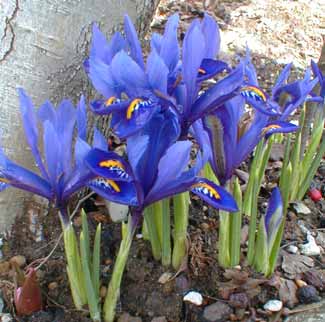
Miniature Iris
aka Dwarf Wild Iris
aka Rockgarden Iris
aka Netted Iris.
"Blossom by blossom the spring begins."
-Algernon Swinburne
(1837-1909)
(1837-1909)
Native of the Caucasus -- Iran, Iraq, Turkey & Georgia -- Iris reticulata blooms late winter or early spring, in shades of blue & purple. In some gardens they bloom as early as January, but for us, this wild natural form begins flowering at the start of the second week of February & is done by mid-March.
If one has additional cultivars, they do not all bloom at identical times; we also have I. reticulata 'Natascha' which begins blooming a few days to two weeks later, but with long overlap of bloom time; 'Purple Gem' which blooms a few days or a week later still; & I. histroides 'Katherine Hodgkin' which blooms immediately after the wild blue reticulated iris but before 'Natascha.' Plus there's Hermodactylus tuberosa (formerly Iris tuberosa) the little Snake's-head irises which likewise get a jump on spring.
If one were to plant a number of varieties, it would be possible to arrange them so as to have one or another of these netted irises blooming early February to early April. We'll be adding more cultivars over time. In years when the crocuses have been prematurely beaten down by heavy rains, reticulated irises make up for that disappointment, for short though their presence can seem, that presence is reliable.
We also have the dwarf I. danfordiae growing a little higher in the rockery; it sometimes starts blooming even before the wild blue, & is lovely for the brightness of its yellow which cannot be obtained in any variety of I. reticulata. But the yellow dwarf is never overall as perfect in presentation, for even moderate rains beat that one down; it does not have as classic an iris shape to its flower; & it does not bloom as well for consecutive years. I greatly prefer I. rediculata which perform better by far & look great even on rainy days.
The blooms have a sweet violet-like scent, though it's awfully subtle, & you have to put your nose practically inside them to detect anything. Each flower has six petals, the three reflexed being called "falls," the three upright called "standards," the standards usually smaller than the falls.
They return each year & occasionally naturalize & spread, though sometimes they do die out of the garden after a few years. Treating them like any other iris will do them harm, as they don't like a lot of dampness. That is not to say they cannot be placed near ponds, but must be well above the waterline so that the bulb doesn't steep, because they require quite a dry dormant period in summer.
Well-drained soil is a must; it is often recommended to plant them on mounds or in raised beds. Ours are planted along a rock-garden ledge near the base of a hawthorn tree, so get all the drainage required. Having the front rockery ledge also means they are not at risk of being hidden by larger things, as they only pop upward to between four & six inches.
Even though tiny, they bloom so far ahead of clumping perennials that they can truly dominate a patch of ground for as long as they're in bloom, & only after they are spent do other perennials return in earnest. So if there's a patch of garden that looks awfully bear in late winter but is full of plants when spring is in full sway, that could well be a suitable location for this iris, lending a pre-spring excitement to spots that are quiescent until late March.
The developing bulbs of this wild dwarf were mighty enough to shove one of the rocks loose from the ledge while producing scapes (stems). One morning a twenty-pound hunk of granite was on the ground at the bottom of the wall & had carefully to be restored to its place without smashing the bulbs & scapes.
Given the right location they will be low-maintenance & very easy to grow, but to insure their presence every year, a few supplementary bulbs can be added each autumn, as not all bulbs inevitably survive for later years, & the offsets they produce take a few years to reach flowering age. If they do fully naturalize, after a few years there'll be so many bulblets coming of age that it will no longer be necessary to insert fresh autumn bulbs.
They should be given bulb fertilizer at planting, then again after bloom is completed. When they finish their bloom, the iris grass continues to grow to a foot height & the health of the plant during this time defines how well it will naturalize for coming years. By late spring when the leaves are obviously dying back they can either be clipped down if they seem unsightly, or just left to vanish naturally.
They do well in part shade in many regions, but in our zone full sun is required. When their grass has vanished in late spring, the bulbs will thereafter need a dry period in summer in order to set their underground buds for the next year. The bulbs should not be disturbed for several years, but when flower quality does begin to decline, it is time to dig up the area & separate out some of the bulbs in autumn.
The bulbs have a netting pattern on them that lends the species the occasional common name "Netted Iris." The species name reticulata refers to this same bulb trait.